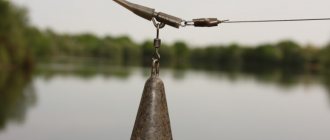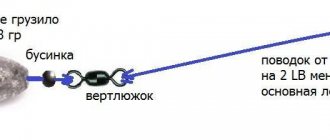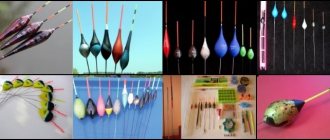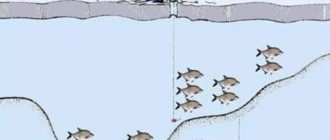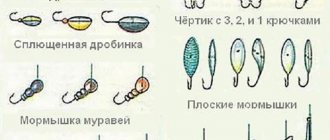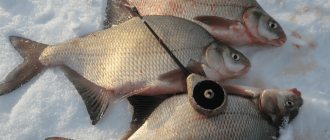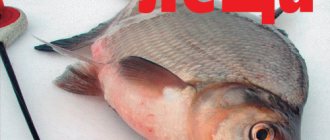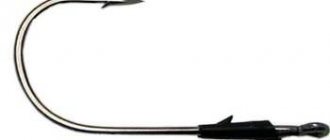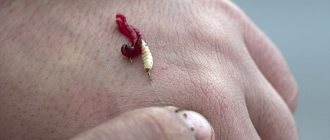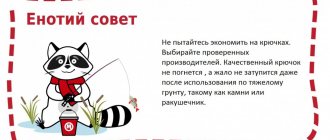But what should beginners do? How to understand which hooks are best to use for catching bream? And how to mount the gear correctly? This article is dedicated to addressing these issues and will highlight what is useful for experienced fishermen and provide answers to questions from beginners.
The obvious thing for every fisherman is that the hook for bream is selected based on the characteristics of the bait used. But questions about the actual wire thickness, optimal shape and the best manufacturer still remain open. As a rule, experienced fishermen have several models in their arsenal that have been tested over many years.
But what should beginners do? How to understand which hooks are best to use for catching bream? And how to mount the gear correctly? This article is dedicated to addressing these issues and will highlight what is useful for experienced fishermen and provide answers to questions from beginners.
Those models that are produced without coating require additional processing - nickel plating, galvanizing or simple coating with waterproof varnish.
Criterias of choice
When choosing hooks for bream, factors such as shape, size, thickness, color and the metal from which they are made are taken into account.
Hook shapes
The shape of the hook - the outline of its hook, the sting, the length of the fore-end. The following common forms of this fishing accessory are used in bream fishing:
Which size to choose
The choice of a particular hook size (number) for bream also depends on the type of gear used:
- For river and lake feeder gear, products No. 10-12 are used. At the same time, the larger ones are used for fishing with worms, the smaller ones - with maggots and bloodworms.
- For a summer float fishing rod, products No. 8-10 (for worms and plant baits), No. 12-14 (for bloodworms, maggots) are more suitable;
- For winter gear (float rod, winter feeder), small items No. 14-16 are used.
In addition to the type of gear, the choice of hook size is also determined by the planned weight of the fish being caught. So, when catching small bream and bream weighing up to 1.5 kg, use products No. 12-14. For larger fish, use hooks No. 10-12.
Thickness and color of hooks
The choice of one or another color of hook for catching bream depends on the bait used:
The thickness of the wire from which these bream accessories are made depends on the fishing season and gear:
- For summer gear, hooks made of wire 0.5-0.7 mm thick are used;
- For ice fishing, products made from thinner wire with a cross section of 0.3-0.4 mm are used.
This difference in wire thickness is explained by the less intense resistance of the fish during fishing in winter.
Material of manufacture
Modern hooks for catching bream are made from the following materials:
Those models that are produced without coating require additional processing - nickel plating, galvanizing or simple coating with waterproof varnish.
Stainless steel products are practically not used for bream. They are used mainly for sea fishing: catching bream on them is unprofitable and impractical.
An important factor when choosing this accessory is the manufacturer. Products from such brands as “Owner”, “Gamakatsu”, “Mustad”, “Korum”, “Kamasan” have gained well-deserved popularity among fishermen. Analogues of budget brands are inferior to them in strength, reliability and durability. Buying a pack of hooks cannot be considered a significant expense, so it’s clearly not worth saving on them.
At the same time, a small hook can simply fly out of the mouth of a large fish when hooking, especially if the bait is tight, even with the sting open. This is why many amateur fishermen prefer to use a larger “normal” hook, even at the expense of its concealability. Others, on the contrary, do not see the dependence of the size of the hook on the size of the fish. In general, the following recommendations can be made:
Characteristics Analysis
In addition to the number, thickness and shape, there are additional factors to consider. For attachment to the fishing line, the design may include a closed ring or blade. The first is convenient for knitting catch, but affects the increase in size. When choosing small sizes, it is recommended to choose a shape with a spatula - after tying a knot, the wire will visually immediately move to the fishing line, without intermediate elements in the form of a ring.
Tips for fisherman: What hooks are needed for catching bream - Features of choice
When choosing, pay attention to the following qualities:
Some manufacturers offer exclusive hooks for this type of fish, supposedly different from the standard ones in shape. In practice, small changes in configuration will not affect the likelihood of a successful catch, and in some cases may negatively affect the bite. It is recommended to choose classic and time-tested models.
The video material reveals the secrets of choosing fishing equipment as fully as possible:
External difference:
What is the shape of the hook for catching bream?
This is perhaps what can matter when fishing for bream. Each angler has his own feeling about which hook will be more catchy. Most often, they use a round “classic” bend shape (the tip can be bent to the side, inward, or remain straight) and a flattened shape, borrowed from fly fishing hooks.
Tips for fisherman: How to cook porridge for bream fishing - Detailed review
You can also find special bream hooks from different manufacturers on sale. This is intended more for a beginner in fishing, who needs to provide equipment, a rod, a feeder and hooks for a specific fish and body of water. Such hooks are no worse than ordinary ones, the main thing is that the quality (read manufacturer) is reliable.
If you fish with a worm, it is better to have a longer fore-end - it will be easier to attach several worms. It is easier to get such a hook, and with an elongated fore-end, the lever is larger and the hook (theoretically) should be more successful.
It is not difficult to choose a round shape; most of these hooks are produced; we recommend hooks like Gamakatsu F22 or LS-3513F (with thinner wire). Although the forend is not long, several worms can easily be attached to Nos. 6-8.
Video about choosing a hook, including for bream.
Video of choosing hooks for bream
There is often an opinion that only with the same size of bream and bait can you count on a good catch. It is only partially true, since in the case of using bloodworms it is true. If the metal part is larger than the bait, the fish may recognize that there is only a hook in its mouth. The result will be a bad bite .
Top 5 best hook manufacturers
- Gamakatsu. One of the popular Japanese fishing tackle manufacturers. The quality of the hooks produced by this company is taken as a basis as a model for other manufacturers. About Gamakatsu we can say that the price-quality ratio is quite justified. This company began its activities more than 50 years ago and during this time has gained its popularity due to its good quality.
- Owner. Japanese tackle manufacturer. These hooks are the most sought after and popular among fishermen. Since they are one of the sharpest, well-sharpened and reliable. Owner hooks are among the most expensive, but the price and quality justifies it. In addition, this company has a very large assortment of hooks.
- Kamasan. Another Japanese hook manufacturer. In popularity, perhaps, it sometimes surpasses the previous manufacturer. The quality is also excellent and many anglers recommend Kamasan hooks for beginners.
- Katana. Japanese tackle manufacturer. The price for a fisherman is quite reasonable. All sizes of hooks are of good quality and reliability.
- Cobra Hooks from this Japanese manufacturer are no less popular among fishermen. The price is quite affordable for anyone, and the quality pleasantly surprises. The hooks are reliable. They can always be found in any fishing store.
[THERE IS AN ANSWER] How to cook millet for bream fishing
Bream is a fairly unpretentious fish, and if you study its habitat, even a novice fisherman can easily catch it. Of course, if you fish in the summer, the catch will be greater. Use all types of bait and hook sizes, as the bream in your pond can be both large and small.
When choosing a hook for catching bream, you need to be guided by several basic rules - these are:
Subtleties of choosing a hook
There are several selection considerations that must be taken into account. Most often attention is paid to fishing conditions :
The choice is also made depending on the type of bait used . The recommendations are as follows:
- You can simplify the installation of the worm by using a hook with an extended shank.
- For bloodworms, the option with a thin wire thickness is more suitable. However, the fragility of the product is determined by the difficulties when catching fish in the autumn or spring.
- If the bait is of animal origin and large, option No. 15-8 is suitable. Thin ones will not be able to withstand the applied load, as a result of which the metal rod breaks off.
Just a few years ago, anglers did not question which hook option was right for a particular task. Now they are paying due attention to this, which is due to the emergence of a large number of versions of this product.
Honest manufacturers indicate the main characteristics of hooks on the factory packaging, and they correspond to reality. Let us assume that we are looking at really high-quality products, made of steel with a reliable coating and good sharpening.
A little about the classification of hooks
On the shelves of fishing stores there are hooks from manufacturers from all over the world. In order for the fisherman to understand for himself what size hook he needs, and for the seller to be able to navigate the buyer’s request, numbering of much-needed products in the equipment of fishing gear, such as, for example, a float rod or a feeder rod, was invented. Unfortunately, there is no uniform standard for numbering such important products for anglers around the world.
On the domestic market there are hooks numbered in different standards:
- in the domestic standard;
- according to international classification;
- according to Japanese classification;
- according to Finnish classification.
The easiest way is to understand what a certain hook number is, classified according to the Russian standard. Russian numbering originated in Soviet times: it is based on the distance from the tip of the sting to the fore-end. On bags with domestic hooks you can see, for example, the following numbering: 6-0, 3-14. Such marks will mean that No. 6 is made of wire 0.3 millimeters thick, its height is 14 millimeters, and the distance from the tip of the sting to the fore-end is 6 millimeters.
The table below will help you understand what the other classifications are:
Materials and colors
An important point when choosing is the material from which the hook is made. The following options are available:
The most common and inexpensive options for applying a protective coating are bronzing and tin plating. The best results are demonstrated by nickel coating applied by galvanization; gilding and silvering demonstrate good results. However, such products are much more expensive than bronzed ones, so not every angler can afford such luxury.
In addition to metallized protective layers, a layer of protective polymer can be applied to the hook, which also provides the corresponding color scheme. A shiny element of equipment is beautiful and pleasing to the angler’s eye, but cautious fish may not appreciate such aesthetics.
Modern manufacturers produce hooks in a variety of colors (red, blue, black, and so on). It is rational to select them according to the color of the environment or bait: for example, red elements are in harmony with earthworms and bloodworms, blue ones blend in with clean water, and black ones are good for silted reservoirs.
For successful fishing, bream, like other fish, should be fed in the future fishing areas. In this case, you can use both plant and animal baits, or artificial, synthetic compounds.
Lures and groundbait for bream
For successful fishing, bream, like other fish, should be fed in the future fishing areas. In this case, you can use both plant and animal baits, or artificial, synthetic compounds.
Vegetable baits
- With regard to vegetable complementary food and bait for bream, it can be corn and pearl barley, peas or dough, up to pasta and boiled potatoes, or simple wheat bread crumb.
- But as experienced fishermen note, when catching bream, it is best to make a “sandwich” on your hook. First, they put a corn grain on a hook, then a star-shaped pasta and 1-2 maggots on top - many people use this bait to lure picky inhabitants of rivers and reservoirs.
Tips for fisherman: How to cook millet for bream fishing - What is the difference, pros and cons
Animal bait
If possible, it is best to catch bream either with a mixed bait, as described above, or use animal bait.
And this can be:
Artificial baits
Of the artificial baits, it is optimal to use crumbled polystyrene foam, used as an independent bait and to raise the hook to the surface of the water.
In addition, it gives the hook vibrations that are attractive to bream, which is especially effective when the water is flowing.
Modern manufacturers produce hooks in a variety of colors (red, blue, black, and so on). It is rational to select them according to the color of the environment or bait: for example, red elements are in harmony with earthworms and bloodworms, blue ones blend in with clean water, and black ones are good for silted reservoirs.
Form
As mentioned above, there are single, double and triple hooks - according to the number of hooks. For most gear and fishing methods, single versions of various configurations are used. Doubles and trebles are mainly used by fans of live bait fishing, and some artificial baits (spinners, wobblers, balancers) are also equipped with them. Objects of hunting: trophy specimens of humpback perch, pike, catfish - in a word, a large predator.
Please note: the underpieces in doubles can be of different sizes, but usually the angle between them is equal to the standard - 120 o. ) always have subdivisions located at the same level at the same angle of 120°.
I would like to say a few words about the widely used offset presses . These models feature a zigzag curve at the top of the forend to securely attach silicone lures. They are used mainly by jig enthusiasts when installing a variety of spaced equipment. We remind you that in the classic version, the hook is integral with the jig head.
D. A hook with a long shank and a barb for fishing with a bunch of worms. A bunch of red worms is a classic and very effective bait for large bream. However, the problem is that the worms slide down and block the point, preventing effective hooking. This hook model eliminates this phenomenon thanks to additional barbs on the fore-end.
A. For use with a feeder and a donkey with bait. The hook is made for fishing with a feeder; its shape makes it easy to hook a bream already at the stage of testing the bait and, thus, before it spits it out and starts moving.
B. Excellent for vegetable baits that hold weakly on the hook. Bream loves to grab bait from plants, but they do not stay on the hook well during vigorous casting. This hook holds the bait very well and allows you to hook effectively even when using harder bait.
B. Very effective hook for corn, wheat, white worms. When fishing, you have to change baits often until you find the best one. This hook makes life easier because it is suitable for a variety of baits and therefore saves the fisherman's labor.
D. An excellent and strong hook for use with a float, mainly for long casting. When fishing for bream, it is often necessary to use a float rod to guide the bait into deep or shallow water. Fishing is extremely effective with long casts. This hook holds dendrobena and big red worms very well and is very effective in a float rig. It is strong enough to hold small carp as bait.
D. A hook with a long shank and a barb for fishing with a bunch of worms. A bunch of red worms is a classic and very effective bait for large bream. However, the problem is that the worms slide down and block the point, preventing effective hooking. This hook model eliminates this phenomenon thanks to additional barbs on the fore-end.
Tips for fisherman: How to cook millet for bream fishing - Let's take it step by step
E. Classic hook for fishing with soft corn. In addition to worms, corn is the most effective bait for bream and is easy to prepare and use. To prevent it from falling off the hook during a long cast, use a properly shaped hook, such as the golden model shown here.
VARIETY OF HOOKS
Properly selected gear for catching bream in the summer will be the key to successful fishing. Their diversity can sometimes confuse a beginner. In fact, everything is much simpler. So, we choose the most catchy one of all.
